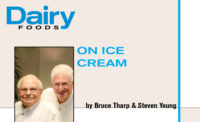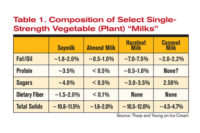There is a growing mandate from health authorities to reduce consumption of sugars (i.e., mono- and di-saccharides). For example, the current Dietary Guidelines for Americans call for significant reduction in calories from “added sugars.” Excluding lactose (which could eventually be included), current frozen desserts can contribute up to 22 grams of added sugars per serving, representing approximately 80% of total calories. The numbers will surge as serving sizes are increased to reflect the amounts typically consumed by Americans.
This has prompted the Food and Drug Administration to include in a proposed modification of nutrition labeling regulations a requirement for the declaration of the level of “added sugars” in the Nutrition Facts panel. That will likely motivate interest in compositional modifications that minimize the amount of added sugars so declared.
As with any change in the sweetener system, the challenges in making such modifications while retaining sensory appeal, heat-shock resistance, behavior at draw temperature, etc., are daunting. Not every sweetener or combination of sweeteners is compatible with formulation considerations. And, matters are now complicated by looming changes to the regulatory roadmap. Add to this the growing demand for more “natural” approaches. Further, the possibility of focusing not only on “sugars” but on caloric contributions from “added sugars” has not been addressed in full.
What we mean by rare sugars
Among the group of sugars are naturally occurring “rare sugars” which provide “sucrose-like” sweetness at ultra-low caloric loads. Rare sugars are found in ultra-small amounts that are difficult to produce commercially and have a range of chemical, physical or nutritional characteristics that may limit (or enhance) their utility. They are either isomers (compounds with similar chemical compositions) or they are epimers (isomers with differing molecular configurations) of more traditional sugars such as sucrose, glucose, fructose, maltose and lactose.
Highly significant is the ability of these rare sugars to interfere with active enzymatic ingestion of themselves and traditional sugars as sources of calories. Rare sugars can mimic the behavior of sugars from which they are made, and indirectly interfere with caloric contributions of each. If used together, the true caloric contribution of any frozen dessert might be able to be altered.
Functional attributes vary
Added nutritional efficacies of some rare sugars include possible pre-biotic influences and low-glycemic indices. In some instances, functional attributes of rare sugars can be quite variable (for example, solubility, negative influence on mix freezing performance, compatibility with specific flavors, etc.). Thus, not all rare sugars are created equal. Some — such as melicitose, allose and turanose — have limited application in food because they are not GRAS (generally recognized as safe). The best known of those that are suitable for food application may be tagatose, a variant of the galactose moiety of lactose, which is almost as sweet as sucrose (approximately 90%) with about 40% of the calories. Tagatose has found commercial success as a value-added tabletop sweetener and dietary supplement.
Another GRAS rare sugar is allulose, which, when properly formulated, has potential for use in frozen desserts. Allulose is an epimer of fructose derived from enzymatic conversion of fructose. Fructose, in turn, is enzymatically derived from glucose. Allulose carries only 0.2 calories per gram and is approximately 70% as sweet as sucrose. Although having leverageable benefits, allulose remains a “sugar” for nutrition labeling purposes, and would be classified as an “added sugar.” However, the ultra- low caloric contribution of allulose makes it worthy of consideration in the “sugaring down” of frozen dairy desserts.
Factors to manage when formulating with allulose and tagatose are exactly the same as with other traditionally sweetened frozen desserts products: balancing formulation objectives, sweetness, freezing performance, water mobility management, resistance to heat shock, etc.
How can this be done? Stay tuned for the discussion of formulating with alternate sugars in “The sugaring-down of frozen desserts: Part II,” which will appear in the September Dairy Foods.
Need more on how to formulate in a changing regulatory environment; update on ingredients and novel approaches, and formulation specifics? Join Bruce Tharp and Steve Young at Tharp & Young on Ice Cream: Technical Short Course, Workshops and Clinics, Nov. 30 to Dec. 2 in Las Vegas. For more on course coverage, registration, course and book discounts, go to www.onicecream.com or call 610-975-4424 or 281-782-4536.




